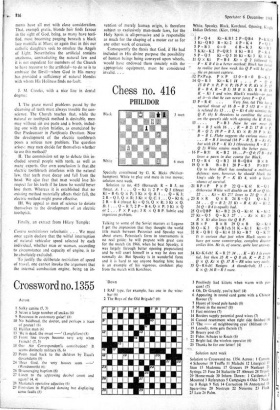Chess no. 416
PHILIDOR
Black White 3 men 6 men Specially contributed by G. K. Hicks (Wolver- hampton). White to play and mate in two moves; solution next week.
Solution to no. 415 (Bernard): R - B 5, no threat. A. 1 . . . Q - Kt 1; 2 P - Q 5 (threat Kt - B 4), Q X P; 3 Kt x Q. B. 1 Q - K 3; 2 R - Q 5, Q x R; 3 Kt x Q. C. 1 Q - Kt 6;
2 R - B 4 (threat Kt - Q 5), Q x R; 3 Kt x Q.
D. 1 . Q - R 7; 2 P - B 4, Q x P; 3 Kt x Q or 2 . . .PxPe.p.; 3R X QB P. Subtle and ingenious problem.
Talking to some of the Soviet masters at Lugano I got the impression that they thought the world title match between Petrosian and Spassky was about evens. Petrosian's form in tournaments is no real guide; he will prepare with great care for the match (in 1966, when he beat Spassky, it was largely through better opening preparation) and he will exert himself in a way he does not normally do. But Spassky is in wonderful form and it is hard to see anyone beating him; here is an example of his vigorous, confident play from the match with Korchnoi. White, Spassky. Black, Korchnoi. Opening, King's Indian Defence. (Kiev, 1968.)
. 1 P-Q 4 Kt-KB3 2 P-QB4 P-KKt3 3 Kt-Q83 B-Kt 2 4 P-K 4 P-Q.3
1P-B3 0-0 6 B-K 3 Kt-B3 7 KKt-K2 P-QR3 8 Kt-B 1 P-K 4 9 P - Q 5 Kt - Q 5 10 Kt - Kt 3 Kt x k:
11 Q X Kt P - B 4 Kt - Q 2 followed b. - • P - K B 4 is a better method; Black has failed to realise just how weak his Q P will be after - the en passant capture.
.12 PxPe.p. P x P 13 0 - 0 - 0 B - K 3 14 Q-R 3 Kt-K1 14 . . . P - Q 4 /5 B P X P, P X P; 16 P x P. Kt x P; 17
B - B 4, R - B 1; 18 B X Kt; B X B; 19 K - Kt I and wins. Black's trouble—or pan of ii—is that he can never force P - Q 4.
15 P - R 4! . . . Very fine. (a) This has a tactical threat of 16 B - B 5 (15 B - B 5' is refuted by 15 . . . Q - Kt 4 ch) winning the Q P. (b) It threatens to combine the attack on the queen's side with opening the K R file 15 . . . . P - B 3 Now he can meet lo
B - B 5 with 16 . . . R - B 2; 17 B x p R - Q 2; 18 P - B 5, Kt X B; 19 P X Kt B - B 1. Flohr suggests the curious move k . . . B - B 3 instead (16 P - R 5, B - Kt 4!) but with 16 P - K Kt 3 (threatening R - R 2 - Q 2) White retains much the better game.
16 P - B 5! R - B 2 /C.. P-Q4: 17 B-8 4
loses a pawn in due course for Black.
17 Q -R 4 Q-B 2 18 B-QB4 B x B
19 Q x B B-B 1 20P-R5 PXBP? Up to here Black has conducted a stubborn defence; now, however, he should block the king's side by P - K Kt 4, with a bencr
- chance of survival.
-21 RPxP P X P 22 Q-K 6! R-QI , Otherwise White will double on K R or Q file 22 . . . Kt - Kt 2?? loses to 23 Q - R
23 R xR QxR 24R-Q1 Q-K2 24 . . . Q - B 2; 25 Kt - R 4; Kt - Kt 2. 26 Q - B 4 is equally bad.
25 QxQBP Kt - B 2 26 Q -Kt 6! K - Kt 2 27 Kt-Q 5 Q-K 3 27 . . . Kt x Kt; 28 R )< Kt also loses the Q B P.
28 BXP BXB 29 QxB Kt-Kt-I 30 Q-K 3 Q-B3ch 31 K - Kt 1 Kt-Q5
32 R-QB 1 Q-Kt4 33 Kt-B7 Q-K 7? It is curious that just when Black seems to have got some counter-play, complete disaster strikes him. He is, of course, quite lost anyway.
Kt-K 6 ch! K - R 2? 34. . . K - Kt 1 is essen- tial, but then 35 R - Q 8 ch, K - R 2; 36 Q X Q, Kt X Q; 37 R - R8 wins very ea.sily. 35 Q-R 6 ch! Resigns A thunderbolt. 35 . . .
K x Q; 36 R - R 1 mate.


































 Previous page
Previous page